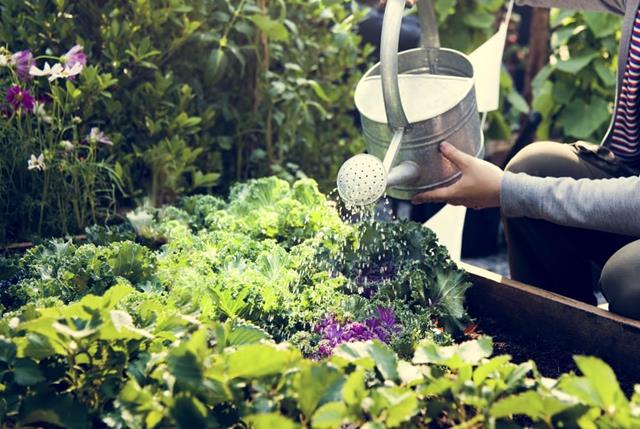During the Great Depression, a time marked by economic hardship and widespread poverty, vegetable gardens and flower gardens played a significant role in the lives of many Americans. In this article, we will delve into the history of these gardens, examining how they provided not only sustenance but also solace in a challenging era.
The Great Depression, which lasted from 1929 to the late 1930s, was characterized by mass unemployment, homelessness, and widespread food scarcity. As families struggled to put food on their tables, vegetable gardens became a vital means of survival. These humble patches of land offered sustenance and a degree of self-sufficiency for families who otherwise had limited access to nutritious meals. Flower gardens also grew in popularity during this time, serving as symbols of hope and beauty amidst desolation.
In this exploration of resilience during the Great Depression, we will uncover how vegetable gardens and flower gardens were essential forms of escape from daily struggles. We will look into the rise of victory gardens as a nationwide movement that arose out of necessity. Additionally, we will examine the social impact these gardens had on communities, fostering unity and cooperation among neighbors striving to overcome adversity together.
Join us as we peel back the layers of history to understand the significance and enduring legacy of vegetable and flower gardens during this tumultuous period in American history. By reflecting on the practices and lessons learned from depression-era gardening, we can gain valuable insights for today’s enthusiasts in our pursuit of sustainable food sources and respite from challenging times.
The Economic Climate
During the Great Depression, the American economy experienced a severe downturn that resulted in widespread unemployment, poverty, and a lack of resources. This economic climate had a significant impact on Americans’ access to both food and flowers.
Rising Food Prices and Scarcity
One of the most immediate challenges faced by Americans during the Great Depression was the rising cost and scarcity of food. As unemployment rates soared, many families struggled to afford basic necessities, including food. The prices of essential items such as meat, dairy products, and fresh produce skyrocketed, making them unaffordable for many households.
To cope with these challenges, people turned to alternative sources of food that were more accessible and affordable. Vegetable gardens became increasingly popular during this time as they provided families with a means to grow their own produce. By cultivating their own vegetables, people could supplement their diet and combat the high prices of store-bought options.
Flowers as a Luxury
While the economic factors primarily affected access to food, flower gardens also felt the impact of The Great Depression in a different way. As people struggled to meet their basic needs, indulging in luxuries like flowers became increasingly challenging.
Flowers were seen as non-essential items and therefore considered low-priority during times of financial hardship. Many individuals could no longer afford to purchase flowers or maintain ornamental gardens due to limited finances. This shift in priorities led to a decline in flower sales and a decrease in public interest in gardening solely for decorative purposes.
However, despite these hardships, gardening enthusiasts found creative ways to incorporate flowers into their landscapes while focusing on practicality as well. Cottage gardens emerged as popular alternatives because they combined both functional plants (such as vegetables) and beautiful flowers. This allowed individuals to enjoy the beauty of nature while also benefiting from edible crops grown at home.
The Rise of Victory Gardens
During the Great Depression, one of the most significant developments in gardening was the rise of Victory Gardens. Victory Gardens were a crucial aspect of individuals’ survival during this challenging time, providing a means to combat food shortages and contribute to the war effort. As the economic climate worsened and unemployment rates soared, many Americans found solace and sustenance in growing their own vegetables.
With limited access to affordable produce and widespread hunger, Americans turned to their backyards or any available green space to cultivate gardens. Victory Gardens became an essential part of daily life, not only for sustenance but also as a way to channel hope and resilience. These gardens played a crucial role in supplementing meager rations provided by relief efforts and helped families stretch their budgets further.
The government played a pivotal role in promoting and supporting Victory Gardens through various initiatives. They emphasized that by growing their own food, individuals were lightening the burden on commercial farmers who needed to focus on supplying troops during World War II.
Communities across the country responded enthusiastically to these calls for action, transforming vacant lots, rooftops, and even public parks into vibrant displays of vegetable patches. The success of these collective efforts highlighted the power of community engagement and collaboration in times of crisis.
Through Victory Gardens, Americans not only grew their own food but also cultivated a sense of empowerment and self-sufficiency. These gardens represented more than just a solution to hunger; they served as symbols of hope for communities ravaged by economic despair. In addition to boosting nutrition levels and filling dinner plates with fresh produce, these gardens rejuvenated spirits by providing a tangible way for people to contribute actively during uncertain times.
Victory Gardens became an enduring symbol of resilience during the Great Depression, leaving behind valuable lessons that continue to inspire today’s generation of gardeners. Their legacy underscores the importance of community support systems during crises, highlighting how collective action can make meaningful change against seemingly insurmountable odds.
Moreover, the rise of Victory Gardens serves as a powerful reminder that even in times of scarcity, individuals can find innovative and creative solutions to provide sustenance for themselves and their loved ones. As we reflect on this period in history, it is evident that these gardens were not merely patches of dirt; they represented the unwavering spirit of Americans determined to persevere through adversity.
Battling Food Insecurity
During the Great Depression, access to food was an ongoing struggle for many Americans. As unemployment rates soared and wages plummeted, families found it increasingly difficult to put food on the table. This dire economic climate led to the rise of vegetable gardens as a means of battling food insecurity and providing nourishment and hope for individuals and communities.
One of the most significant responses to the scarcity of available produce during the Great Depression was the establishment of “Victory Gardens.” These gardens were promoted as a patriotic duty, encouraging citizens to grow their own fruits and vegetables in order to support the war effort by freeing up resources for the military. Victory Gardens not only helped alleviate some of the strain on grocery stores but also empowered individuals with a sense of self-sufficiency and resilience.
To combat food insecurity, families across America harnessed whatever space they had available – from backyards to empty lots – to cultivate their own crops. Even urban areas saw an increase in rooftop gardens and window box plantings.
The act of growing their own food provided families with a newfound source of sustenance that could be counted on during these uncertain times. Vegetable gardens offered a small glimmer of hope, demonstrating that self-reliance and resourcefulness could overcome even the most challenging circumstances.
During this period, growing vegetables was not just about satiating hunger; it also became a powerful symbol of hope. Many gardeners took pride in their ability to provide for themselves and their loved ones, finding solace in watching tender seedlings sprout into life-sustaining plants. Gardening offered not merely physical nourishment but also emotional well-being, serving as a way for individuals to stay connected with nature and experience a sense of renewal amidst economic desolation.
In summary, vegetable gardens played an integral role in battling food insecurity during the Great Depression. These gardens provided much-needed nourishment while instilling hope and resilience in individuals struggling during this tumultuous time. By growing their own food, families not only ensured their survival but also regained a sense of control over their lives and found solace in the natural world around them.
Escaping from Desolation
During the Great Depression, when economic despair and hardship were prevalent, flower gardens served as a source of solace and beauty for many Americans. Despite financial constraints and limited resources, individuals turned to gardening as a means of escaping the desolation that surrounded them.
Creating Beauty Amidst Turmoil
In times of crisis, it is perhaps human nature to seek out beauty and find solace in it. Flower gardens provided exactly that during the Great Depression. The act of cultivating and nurturing vibrant flowers brought a sense of purpose and hope into people’s lives. For those grappling with financial uncertainty and feelings of helplessness, tending to flower gardens offered a respite from their day-to-day struggles.
The sight of colorful blooms amidst bleak surroundings brought joy to both gardeners and passersby. Many families would carefully arrange freshly cut flowers in vases, adorning their tables with splashes of color that provided a small escape from the harsh reality outside their homes. In this way, flower gardens not only beautified individual lives but also brought moments of respite and happiness to communities at large.
Symbols of Hope
Flower gardens took on even greater significance during the Great Depression as symbols of resilience and hope. By investing time and effort into creating beautiful spaces with limited resources, gardeners reminded themselves and others that beauty was still possible even in the face of adversity.
These flower gardens became emblematic of the human spirit’s ability to endure challenging times and find solace within nature. They provided a tangible reminder that despite the economic turmoil, there was still room for beauty, growth, and renewal.
Therapeutic Effects
Beyond just offering visual beauty, flower gardens also provided individuals with therapeutic benefits during a time when mental health concerns were often neglected or misunderstood. Gardening required dedication and commitment from individuals who had little control over other aspects of their lives. This sense of agency and purpose allowed gardeners to channel their energy into something positive, creating a sanctuary in the process.
In addition, tending to flower gardens offered a welcome distraction from the daily hardships that many faced. The act of working with soil, the scents of blossoming flowers, and the gentle sway of petals in the wind provided a calming escape from worries and anxieties. Flower gardens became havens where individuals could find solace and peace amidst the turmoil of the Great Depression.
Overall, flower gardens played a vital role in beautifying lives during the Great Depression. They offered respite, symbolized hope, and provided therapeutic effects for those grappling with unimaginable challenges. Their legacy serves as a reminder of the enduring power of nature’s beauty to lift spirits and foster resilience even in times of despair.
Community Support and Social Impact
During the Great Depression, vegetable and flower gardens played a crucial role in fostering unity and cooperation within communities. The challenging economic climate pushed Americans to come together and support each other, and gardening became a way for neighbors to work collaboratively towards a common goal.
One of the ways that vegetable gardens fostered unity was through community garden projects. These projects involved individuals pooling their resources, skills, and labor to cultivate a shared plot of land. By working together, they were able to maximize productivity and ensure that everyone had access to fresh produce.
In addition to providing food security, these community gardens also created a sense of camaraderie amongst participants. People would often gather at the garden to exchange tips, share stories, and build relationships based on their shared interest in gardening.
Another significant impact of vegetable and flower gardens during the Depression era was the creation of cooperative societies or clubs dedicated specifically to gardening. These groups brought like-minded individuals together with the aim of supporting each other in their gardening endeavors. Members would share seeds, tools, and knowledge about effective gardening techniques. They would also organize events such as seed swaps or plant sales, where members could trade or sell surplus produce or ornamental plants with each other.
The social impact of flower gardens during the Great Depression cannot be overlooked either. While vegetable gardens provided sustenance, flower gardens offered solace and beauty during difficult times. Many people found comfort in tending to their flower gardens as a means of escapism from the harsh realities of daily life.
The vibrant colors and delicate fragrances uplifted spirits and provided a temporary respite from desolation. Moreover, flowers were often given as gifts or used for special occasions such as weddings or funerals, symbolizing hope, love, and remembrance.
To sum up, vegetable and flower gardens became catalysts for building stronger communities during the challenging years of the Great Depression. Through collaborative efforts in community garden projects and participation in gardening clubs, individuals came together to support each other and combat food insecurity.
Meanwhile, flower gardens provided solace, beauty, and a sense of hope in the midst of despair. The enduring legacy of these Depression-era gardens serves as a reminder of the power of unity and cooperation in times of adversity.
Innovation and Creativity
During the Great Depression, individuals and families faced significant challenges in terms of food security and maintaining their overall well-being. In response to these difficulties, people turned to gardening as a means of sustenance, self-sufficiency, and even as a form of therapy. This section explores the innovative techniques and practices that emerged during this time period, highlighting how individuals adapted to the economic circumstances and utilized limited resources to create bountiful gardens.
One notable aspect of Depression-era gardening was the creative use of small or unconventional spaces for planting. With limited land available in urban areas, people sought alternative solutions such as rooftop gardens, container gardening, and vertical gardening. Rooftop gardens provided an opportunity for city dwellers to grow their own vegetables and flowers despite space constraints.
Container gardening involved using various containers such as buckets or ceramic pots to cultivate plants in small areas like balconies or windowsills. Vertical gardening was another technique that allowed individuals to maximize space by utilizing walls or fences for growing climbing plants.
Furthermore, resourcefulness played a vital role in Depression-era gardens. Due to financial constraints, gardeners often relied on inexpensive or recycled materials for garden structures and tools. For instance, instead of purchasing expensive plant supports or trellises, they would repurpose items such as old ladders or chicken wire as sturdy alternatives. Similarly, composting became increasingly popular as a way to enrich soil fertility without spending additional money on fertilizers.
| Technique/Practice | Description |
|---|---|
| Rooftop Gardens | Urban dwellers utilized rooftops for cultivating vegetables and flowers. |
| Container Gardening | Gardeners planted in various containers to maximize space, such as buckets or pots. |
| Vertical Gardening | Growing plants vertically on walls or fences to conserve space. |
| Resourceful Structures | Repurposing materials like old ladders or chicken wire for plant supports and trellises. |
| Composting | Using organic waste to create nutrient-rich compost for improving soil fertility. |
These innovative techniques and practices not only enabled individuals and families to produce their own food, but they also fostered a sense of empowerment and self-reliance during a time of great hardship. Depression-era gardening showcased the resilience and adaptability of people who were determined to provide for themselves and their communities. Today, these practices serve as a source of inspiration for modern gardeners looking to make efficient use of limited resources and cultivate their gardens with creativity.
The Enduring Legacy
During the Great Depression, vegetable and flower gardens played a crucial role in providing food, beauty, and hope to individuals and communities struggling with economic hardship. These Depression-era gardens not only served as a source of nourishment but also provided comfort and solace in times of despair. The lessons learned from these gardens continue to hold relevance for food and flower enthusiasts today.
One important lesson from Depression-era gardening is the value of self-sufficiency. As people faced limited access to affordable food during the economic crisis, they turned to their own gardens to grow their sustenance. This taught them the importance of cultivating their own food sources and relying less on external systems. Today, we can apply this lesson by growing our own fruits, vegetables, and herbs in backyard or community gardens, thereby reducing dependence on supermarkets.
Another lesson we can learn from Depression-era gardens is the power of community support and cooperation. During this time, neighbors would often come together to exchange seeds, share knowledge about gardening techniques, and provide assistance when needed.
This sense of unity not only helped alleviate individual struggles but also fostered a stronger connection within communities. In our modern society, forming community garden projects or joining local horticultural societies can promote collaboration among like-minded individuals while creating spaces for sharing resources and knowledge.
Lastly, Depression-era gardens showcase the beauty that can be found even in times of struggle. Flower gardens became a source of joy and inspiration for many individuals during this bleak period. Planting flowers allowed one’s spirit to bloom despite the uncertainty surrounding them. Similarly, incorporating flowers into our contemporary landscapes can bring color and positivity into our lives amidst challenging times.
The enduring legacy of Depression-era gardens serves as a reminder that even in difficult circumstances, gardening has the power to sustain both body and soul. By embracing self-sufficiency practices, fostering community connections, and finding beauty in nature’s offerings, we can draw inspiration from those who cultivated resilience through their gardens during the Great Depression.
| Lesson | Application Today |
|---|---|
| Self-sufficiency | Growing our own food sources to reduce dependence on supermarkets. |
| Community support and cooperation | Forming community garden projects or joining horticultural societies for collaboration and resource sharing. |
| Finding beauty in difficult times | Incorporating flowers into our landscapes for color and positivity. |
Conclusion
In conclusion, the history of vegetable and flower gardens during the Great Depression highlights the resilience and resourcefulness of individuals during challenging times. Despite the economic climate and limited access to food and flowers, people found solace in gardening as a means of survival and escape from desolation.
Vegetable gardens played a crucial role in battling food insecurity, providing nourishment and hope to families across America. Flower gardens, on the other hand, brought beauty and joy into people’s lives, offering a small reprieve from the harsh realities of the Great Depression.
The rise of victory gardens during this period demonstrated not only the determination of individuals to take matters into their own hands but also showcased how communities came together in times of need. These gardens fostered unity and cooperation among neighbors, as people shared resources and knowledge to ensure everyone had enough to eat.
The social impact of vegetable and flower gardens cannot be overstated – they provided a sense of purpose, community support, and even served as therapeutic outlets for those facing immense hardship.
Moreover, depression-era gardening sparked innovation and creativity in developing unique techniques and practices. Individuals experimented with limited resources to maximize yields and make the most out of their plots. These innovative strategies have been carried forward to modern-day gardening enthusiasts who continue to learn from the lessons of those who came before them.
Looking back at the historical significance of vegetable and flower gardens during the Great Depression serves as a reminder that even amidst adversity, there is power in nature’s ability to provide sustenance, beauty, and healing for both individuals and communities alike. As we navigate our own challenges today, we can draw inspiration from these stories to find strength in our gardens – be it growing our own food or cultivating flowers that uplift our spirits.
The legacy of depression-era gardens reminds us that through simple acts like gardening, we can find hope, resilience, and connection with one another.

If you’re looking to get into vegetable gardening, or are just looking for some tips on how to make your current garden better, then you’ve come to the right place! My name is Ethel and I have been gardening for years. In this blog, I’m going to share with you some of my best tips on how to create a successful vegetable garden.





